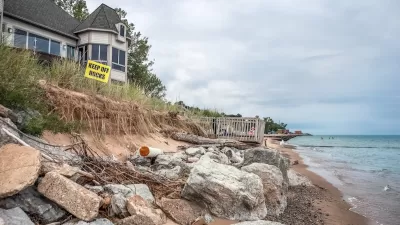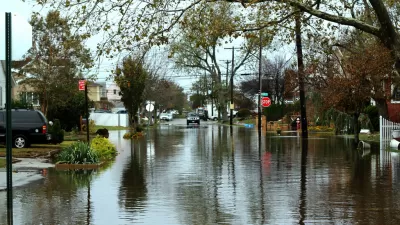Climate change and rising seas will mean higher flood risks for cities. But when exactly will impactful flooding become a regular occurrence? New analysis by the Union of Concerned Scientists says that time is fast approaching.
Planners working on resilience against flooding take heed. A report, released this month by the Union of Concerned Scientists, says tidal flooding may soon affect urban areas, especially on the Atlantic and Gulf coasts. Forecasts of hurricane and storm risks are plentiful in the wake of Sandy and Katrina, but research into higher tides is harder to come by.
Melanie Fitzpatrick, one of the researchers who compiled the report, remarked, “The shock for us was that tidal flooding could become the new normal in the next 15 years; we didn’t think it would be so soon.”
The team used sea-level data from the recent National Climate Assessment and from Climate Central to determine that “in the absence of flood-deflecting marshes, seawalls or levees, two-thirds of the 52 communities studied can expect a tripling in the frequency of high-tide flooding during the next 15 years.”
The researchers conclude that tidal “nuisance flooding,” though not as dramatic as a major storm, is a real and apparent resilience challenge. They advocate communication between affected cities to coordinate best responses. The article includes an interactive map that displays the report’s flooding predictions for U.S. cities based on a number of parameters.
FULL STORY: Sea Level Rise Making Floods Routine for Coastal Cities

Trump Administration Could Effectively End Housing Voucher Program
Federal officials are eyeing major cuts to the Section 8 program that helps millions of low-income households pay rent.

Planetizen Federal Action Tracker
A weekly monitor of how Trump’s orders and actions are impacting planners and planning in America.

Ken Jennings Launches Transit Web Series
The Jeopardy champ wants you to ride public transit.

Congress Moves to End Reconnecting Communities and Related Grants
The House Transportation and Infrastructure Committee moved to rescind funding for the Neighborhood Equity and Access program, which funds highway removals, freeway caps, transit projects, pedestrian infrastructure, and more.

From Throughway to Public Space: Taking Back the American Street
How the Covid-19 pandemic taught us new ways to reclaim city streets from cars.

Opinion: Transit Agencies Must View Service Cuts as Last Resort
Reducing service could cripple transit systems by pushing more riders to consider car ownership, making future recovery even less certain.
Urban Design for Planners 1: Software Tools
This six-course series explores essential urban design concepts using open source software and equips planners with the tools they need to participate fully in the urban design process.
Planning for Universal Design
Learn the tools for implementing Universal Design in planning regulations.
Heyer Gruel & Associates PA
Ada County Highway District
Institute for Housing and Urban Development Studies (IHS)
City of Grandview
Harvard GSD Executive Education
Toledo-Lucas County Plan Commissions
Salt Lake City
NYU Wagner Graduate School of Public Service





























